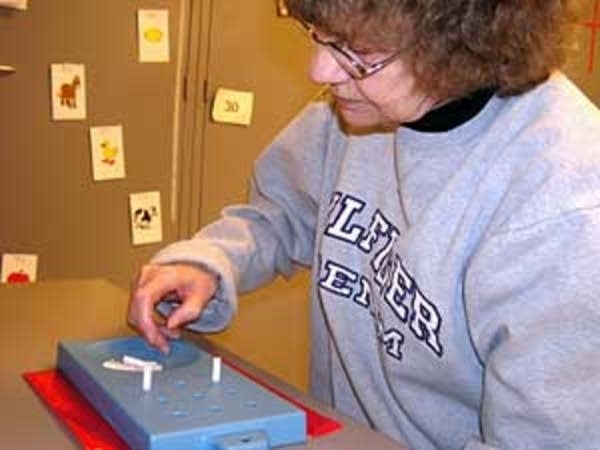Robotic device speeds stroke recovery

Early on a Tuesday morning occupational therapist Matthew White is getting started with his first appointment of the day.
He reaches for a Goniometer, a device to measure range of motion, and inches his chair closer to Janice Straumann who's sitting quietly nearby.
White asks her to lift her arm.

"We're just gonna see where your shoulder is today. So I'm going to have you do shoulder flexion," says White. "I want you to reach forward and all the way up. Go as high as you can. Keep going. Keep going."
Create a More Connected Minnesota
MPR News is your trusted resource for the news you need. With your support, MPR News brings accessible, courageous journalism and authentic conversation to everyone - free of paywalls and barriers. Your gift makes a difference.
When Straumann tells him she can't lift her arm anymore White takes a measurement.
"Alright. That's five degrees more," "That's good. That's the right direction."
Straumann has improved a lot since her stroke last March. At the time she was a fit 64-year-old with an extremely active lifestyle. A stroke paralyzed the right side of her body leaving her unable to walk or use her arm. Her fingers muscles contracted into a fist and her elbow bent, pulling her arm in tight to her chest.

The event changed her life completely. "(I)couldn't babysit the grandkids anymore," says Straumann. "Making a meal was a big trial."
Straumann still can't babysit her grandkids, but now she can take care of herself.
"I do my cereal now. I eat my cereal with my bad hand," she says. "That's an accomplishment."
Straumann credits much of her recovery to a device called InMotion2, a robotic arm that helps patients perform strengthening exercises. Sister Kenny Rehabilitation Institute at Abbott Northwestern Hospital is the first in Minnesota to use the device for stroke rehabilitation.
"I do my cereal now. I eat my cereal with my bad hand. That's an accomplishment!"
InMotion2 was designed by researchers at the Massachusetts Institute of Technology. They created the robotic device to help patients maximize exercises that help their brain form new paths to compensate for their injuries. The brain's ability to form these new connections is called neuroplasticity. It takes a lot of exercise repetition to solidify the new connections.
Straumann has used the device for several months. Her arm strength has improved so much that she spins through a series of exercises with minimal effort.
There's not much to hear besides the soft whir of the robotic motor. But there's a lot to see as the machine guides Straumann through a maze on a computer screen.
Her arm is strapped into a trough equipped with a joystick for the hand. She uses the joystick to follow the movements of a cursor as it moves throughout the maze.

When her strength wanes during the exercise, the robotic arm gives her a little assistance.
"(It) lets my arm do it right instead of messing up all the time. And that's a lot of it too. If you can do something and it works, right? Get a little more faith in that arm. None before," says Straumann.
Occupational therapist Matthew White says the robotic arm offers patients the kind of exercise intensity he can't give them.
With the aid of the device patients can perform up to 1000 movements an hour.
"If you just kind of look at it at face value," says White, "if we know that patients need a ton of repetition, as a therapist can I provide a thousand repetitions in one hour and then see six other patients that day? You know, realistically, no."
White says the device also speeds up a patient's recovery, which is becoming more and more important as patients hit limits on their insurance coverage.
"That's what it comes down to. As people get kicked out of the hospital sooner, they get less rehab, we need to be more creative and more efficient and effective in the type of rehab we're doing," says White. "And that's why we're looking towards robotic therapy."
White and his colleagues still rely on many old fashioned therapies to treat stroke victims. For example, some patients at the clinic practice their coordination by picking up dried beans with a spoon. White says the exercise is simple and it works well.
But he says there are other motor skill issues - like walking - where a robot's assistance could be particularly useful. The Sister Kenny Rehabilitation Institute hopes to add a robotic-aided leg machine in the near future.
